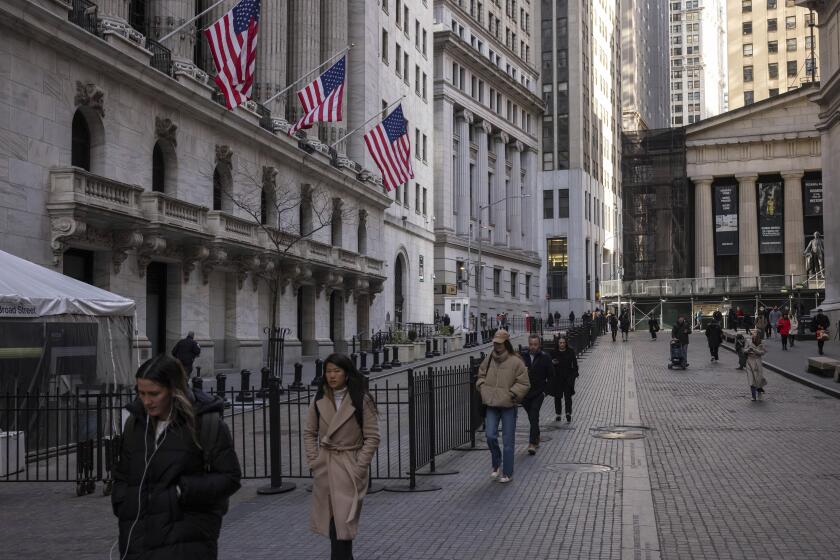Despite Profit, Glenfed Is Takeover Bait : Reputation From Early ‘80s Holds Company Back, Executive Says
Glenfed Inc., the parent of Glendale Federal Savings & Loan, is one of the biggest and most prosperous S&L; holding companies in the country. Despite a $250-million-plus acquisition spree in recent years, Glenfed’s earnings have soared an average 59% a year since 1983, and its return on average stockholders’ equity last year was 18%, among the highest in the business.
And what has been Glenfed’s reward for its profitable showing? A stock that trades 45% below the company’s book value, a stock so cheap that it has turned the Glendale-based company--with assets of $23 billion--into takeover bait.
“It’s frustrating,” said Keith P. Russell Jr., Glenfed’s chief operating officer. “We are exceptionally undervalued considering the franchise we have.” And, said Gerald S. Haims, an S&L; analyst with Seidler Amdec Securities, Glenfed “could be considered a target” of a potential raider.
Along the way, Glenfed has become the fifth-biggest savings and loan in the nation by aggressively buying other S&Ls; in the past several years and has also bought several companies involved in title insurance brokerage, escrow services, mortgage banking and real estate development.
Trying to Change Image
One of the architects of Glenfed’s expansion drive is Norman M. Coulson, a 30-year Glenfed veteran and now its vice chairman and chief executive. He pushed Glenfed into new areas to generate more profits, but he has also been careful to buy only companies closely related to Glenfed’s bread and butter business--making mortgage loans.
“I’ve seen them come and go, the flashy guys,” Coulson said in reference to S&L; chieftains who expanded beyond their expertise and then needed a bailout by the Federal Savings and Loan Insurance Corp., a federal agency that insures consumer deposits up to $100,000.
Coulson has also worked hard to shift Glenfed’s loan portfolio from fixed interest rates to adjustable rates so that a sudden surge in rates would not cripple its earnings. But not enough people seem to have noticed.
In his spacious office atop Glenfed’s 14-story headquarters building, Coulson said the company must keep piling up good earnings results to convince institutional investors that it deserves a second look. The company still suffers, he said, from the reputation it earned as a poor performer in the early 1980s, when Glenfed and many other S&Ls; got hammered by soaring interest rates.
In those days, Glenfed had mostly fixed-rate mortgages and, amid deregulation of the savings industry, had to start paying variable rates on deposits. As rates skyrocketed, so did the S&Ls;’ interest costs, but their interest income did not keep pace because of the fixed-rate loans.
Down went the company’s profits, from $31.7 million in 1980 to $7.5 million in 1981, and to a loss of $16.7 million in 1982.
Now, about 85% of its loans have rates that change along with its deposits, up from a 10% match five years ago, Russell said. The upshot is that Glenfed’s loans consistently earn about 2.5 percentage points more than its deposits cost, no matter what interest rates do.
As a result, Glenfed’s profit swelled to $148.7 million in its fiscal year that ended last June 30 from $23.8 million in fiscal 1983, although in the nine months that ended March 31, Glenfed’s net income slipped 5% to $116.7 million. Regardless, “we haven’t convinced the investment community that we can weather a high interest rate storm again,” said the 55-year-old Coulson.
Underpriced and Vulnerable
Wall Street’s caution shows in the company’s stock price. Glenfed, which went public at $13.75 a share in October, 1983, closed Monday at $20.625 a share on the New York Stock Exchange. The price is well below its all-time high of $33.50 a share, below Glenfed’s book value (net worth) of about $37.50 a share and below what some analysts estimate is Glenfed’s breakup value of $40 a share or more.
The result: Glenfed remains “vulnerable,” as Coulson puts it. The institution does not face a hostile suitor at the moment, but Royal Trustco Ltd. of Canada made a threatening pass at the S&L; in November and still owns 9.9% of Glenfed’s stock.
Part of the reason the stock is cheap is that recent big losses at Irvine-based Financial Corp. of America, the biggest U.S. thrift holding company, and elsewhere in the S&L; industry have left Wall Street cool toward financial stocks. Standard & Poor’s index of 42 financial stocks is up only 3% this year after tumbling 19.7% in 1987.
When investors do decide to buy S&L; stocks, Coulson said, they favor “the darlings of the industry”: H. F. Ahmanson, the parent of Home Savings of America; Great Western Financial, and Calfed, owner of California Federal, all of which are larger than Glenfed.
Glenfed has some support from big investors. Fidelity Investments, the giant mutual fund manager, owns 1.2 million Glenfed shares spread among three funds and has owned various amounts of the stock since Glenfed went public, David Ellison, a Fidelity portfolio manager, said.
“We own it because we think management’s done a good job,” Ellison said, but he conceded that lately the stock “hasn’t acted well.”
Expansion in Works
Glenfed, formed in 1934 by former typewriter salesman Joseph E. Hoeft, operates 148 branches in California and 70 branches in Florida, where it owns First Federal Savings of Broward County and Tampa Federal Savings.
Last fall, Glenfed also bought Guarantee Financial, the Fresno-based parent of Guarantee Savings, and it plans to move into Washington state with its proposed purchase of the 22-branch University Savings Bank of Seattle for $75 million, which would expand Glenfed’s overall system to 240 branches.
The company spent three years studying the Seattle market before deciding to buy University Savings. And University would be Glenfed’s first out-of-state S&L; purchase since it bought First Federal of Broward and Tampa Federal in Florida in 1981 and 1982, respectively.
Glenfed also is known as a stodgy lender, assuming minimal risk even if it means turning away business. But its loan quality sparkles. Delinquent loans and other bad assets amount to only 1.3% of Glenfed’s total assets, compared to the 1.8% average for other healthy, publicly traded thrifts, said Joseph A. Jolson, an S&L; analyst with Montgomery Securities.
None of which was lost on Royal Trustco. Last November, when Glenfed also was selling in the mid-$20s, Royal Trustco bought 8.6% (a stake now up to 9.9%) of Glenfed’s 29 million common shares and hinted that it might seek control. The news caught Coulson off guard.
“At first I thought, ‘Gee, this is really great; a very sophisticated investor took a position in this company,’ ” Coulson recalled. But he then realized that Royal Trustco had invested only $22 a share in a company with a book value of more than $35 a share. Glenfed, in other words, could be had for bargain prices.
Disruptive Nibbling
“I was quite concerned,” Coulson said. A month later, Glenfed adopted a stockholder’s rights plan, commonly known as a “poison pill,” intended to deter a hostile takeover of Glenfed. Coulson would not have to worry, though, if Glenfed succumbed to a hostile takeover. He would still be paid $1 million over two years after the S&L; changed hands.
Although Glenfed adopted a poison pill, Coulson said he is a “free-market guy” who is “not worried about keeping my job” if Glenfed gets an attractive takeover bid. “I would have no problem if somebody wanted to come in and make a full offer for the company,” he said.
But in a not-so-veiled swipe at Royal Trustco, Coulson said that “to nibble at us is very disturbing and very disruptive.”
GLENFED VS. OTHER MAJOR CALIFORNIA SAVINGS & LOANS The chart below compares several key indicators of Glenfed’s financial performance against some other major S&Ls; based in California. In addition to assets and profits, the chart lists their return on average equity (or the company’s annual profit divided by its net worth), which gives investors an idea of how well their money is being employed. The return on average assets figure (profit divided by average assets) is another important benchmark of an S&L;’s performance: a 1.00% ROA is considered excellent. Finally, the equity-to-assets ratio measures the amount of investors’ capital the S&L; has available to support its growth--and usually the higher the ratio, the better.
Figures are for Glenfed’s fiscal year ended June 30, 1987; all others for year ended Dec. 31, 1987.
Return Return on avg. on avg. S&L; Assets Profit equity assets H.F. Ahmanson $30.51 billion $200.2 million 11.5% 0.69% (Home Savings) Great Western $28.63 billion $210.1 million 12.3% 0.73% Calfed $24.58 billion $166.9 million 14.0% 0.73% (California Federal) Glenfed $18.93 billion $148.7 million 18.04% 0.84% (Glendale Federal) Golden West $12.84 billion $146.9 million 20.4% 1.16% (World Savings)
Equity to assets S&L; ratio H.F. Ahmanson 5.9% (Home Savings) Great Western 6.5% Calfed 5.1% (California Federal) Glenfed 4.7% (Glendale Federal) Golden West 6.2% (World Savings)







